Analysis of Mr. Khin's Human Development: NURS2003 Case Study Report
VerifiedAdded on 2022/12/26
|17
|5431
|3
Case Study
AI Summary
This case study presents an analysis of Mr. Khin, a retired individual, exploring the various factors that have influenced his human development. The study examines biological factors such as genetics, BMI, and lifestyle choices, highlighting potential health risks and protective behaviors. Psychological factors, including cognitive function, memory, and social connections, are also considered, along with the impact of retirement and mental well-being. Furthermore, the study assesses the influence of social determinants, including socioeconomic status, family structure, and social support networks, on Mr. Khin's overall health and quality of life. Based on these factors, the study offers predictions for Mr. Khin's health and well-being over the next five years. The case study also includes an interview and naturalistic observation to gather comprehensive data on Mr. Khin's life. The study is aligned with the course objectives of NURS2003, focusing on the biological basis of development and elderly health.

Running head: CASE REPORT
NURS2003 Case Study
Name of the Student
Student ID
Name of the University
Author Note
NURS2003 Case Study
Name of the Student
Student ID
Name of the University
Author Note
Paraphrase This Document
Need a fresh take? Get an instant paraphrase of this document with our AI Paraphraser
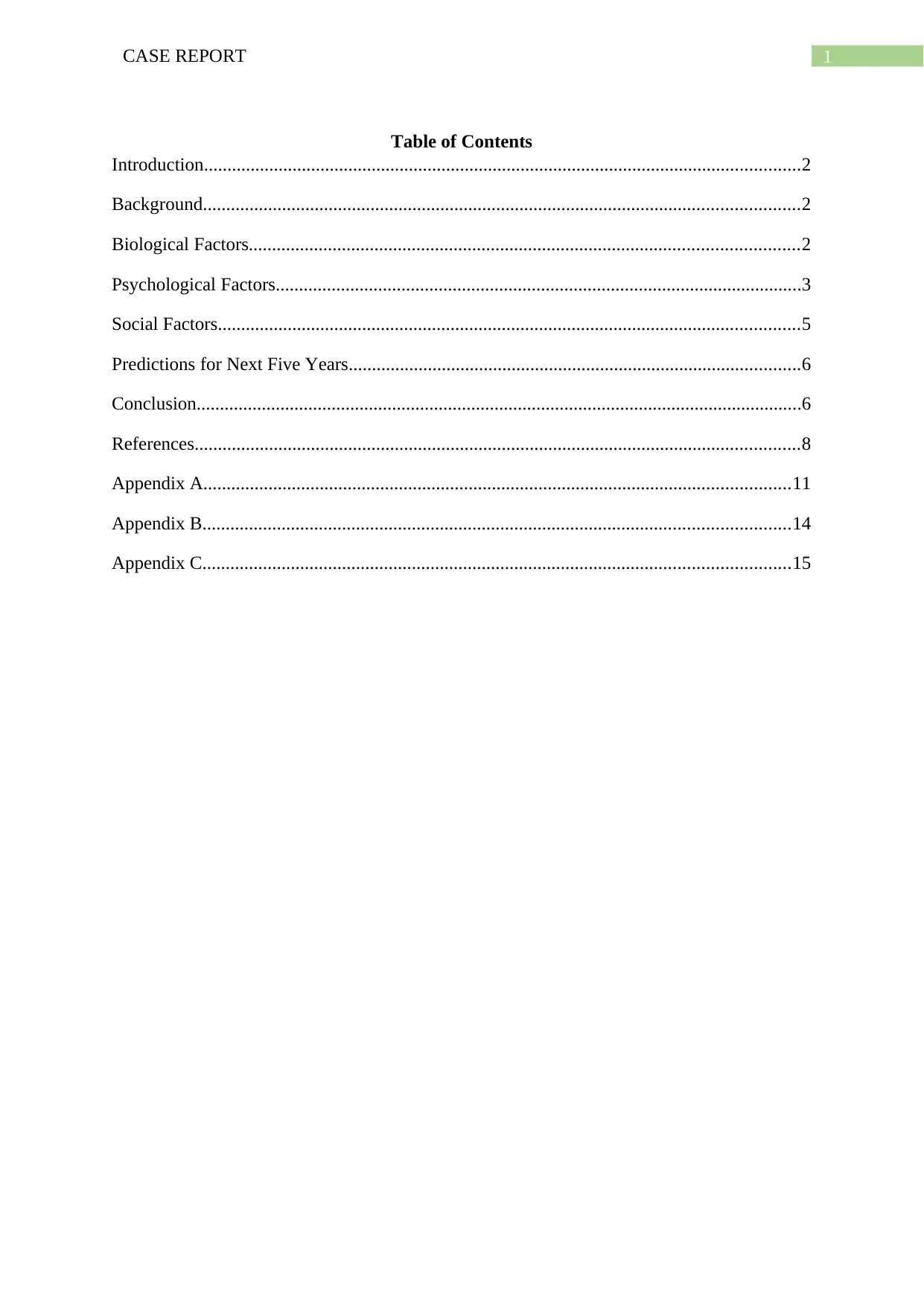
1CASE REPORT
Table of Contents
Introduction................................................................................................................................2
Background................................................................................................................................2
Biological Factors......................................................................................................................2
Psychological Factors.................................................................................................................3
Social Factors.............................................................................................................................5
Predictions for Next Five Years.................................................................................................6
Conclusion..................................................................................................................................6
References..................................................................................................................................8
Appendix A..............................................................................................................................11
Appendix B..............................................................................................................................14
Appendix C..............................................................................................................................15
Table of Contents
Introduction................................................................................................................................2
Background................................................................................................................................2
Biological Factors......................................................................................................................2
Psychological Factors.................................................................................................................3
Social Factors.............................................................................................................................5
Predictions for Next Five Years.................................................................................................6
Conclusion..................................................................................................................................6
References..................................................................................................................................8
Appendix A..............................................................................................................................11
Appendix B..............................................................................................................................14
Appendix C..............................................................................................................................15
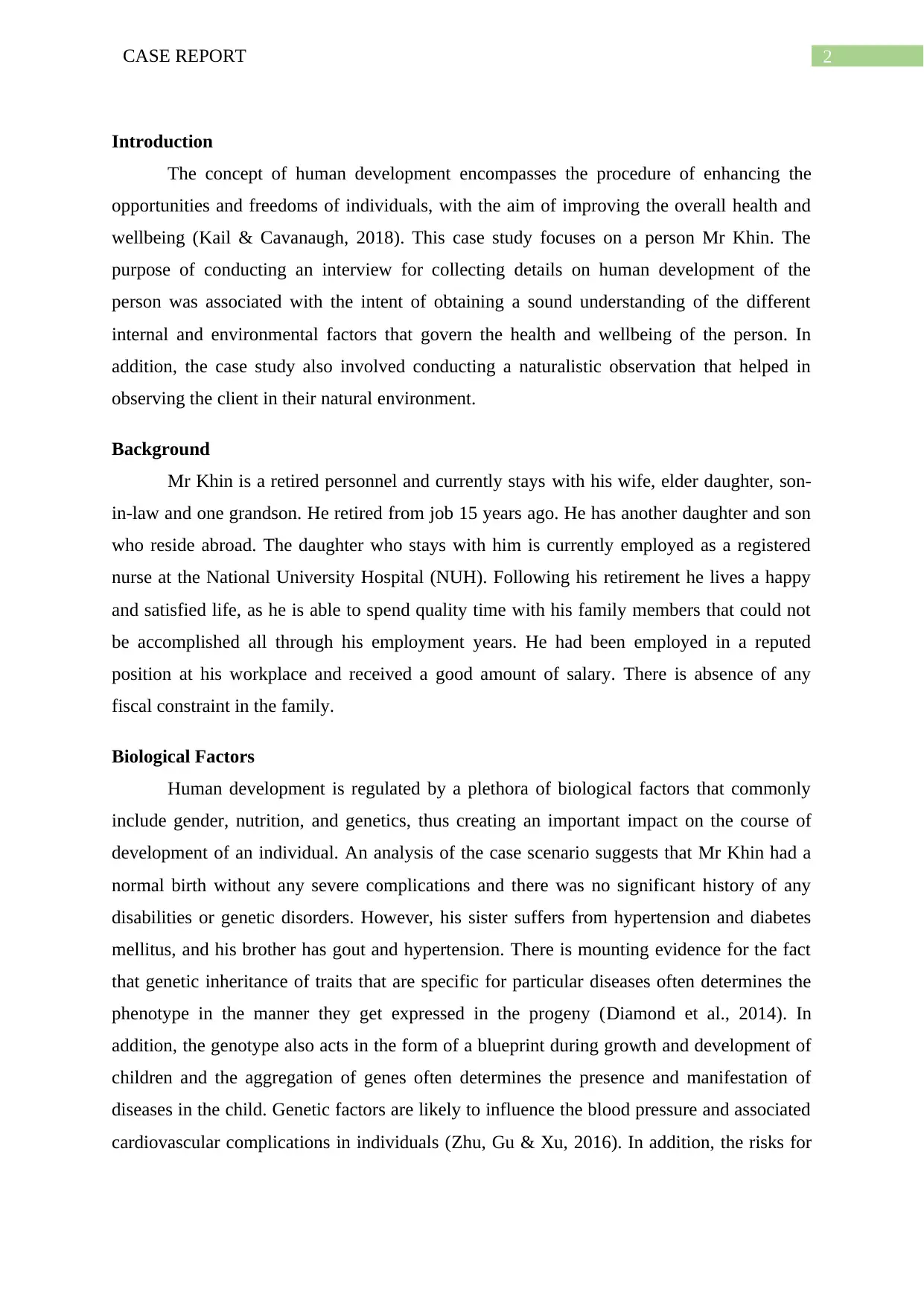
2CASE REPORT
Introduction
The concept of human development encompasses the procedure of enhancing the
opportunities and freedoms of individuals, with the aim of improving the overall health and
wellbeing (Kail & Cavanaugh, 2018). This case study focuses on a person Mr Khin. The
purpose of conducting an interview for collecting details on human development of the
person was associated with the intent of obtaining a sound understanding of the different
internal and environmental factors that govern the health and wellbeing of the person. In
addition, the case study also involved conducting a naturalistic observation that helped in
observing the client in their natural environment.
Background
Mr Khin is a retired personnel and currently stays with his wife, elder daughter, son-
in-law and one grandson. He retired from job 15 years ago. He has another daughter and son
who reside abroad. The daughter who stays with him is currently employed as a registered
nurse at the National University Hospital (NUH). Following his retirement he lives a happy
and satisfied life, as he is able to spend quality time with his family members that could not
be accomplished all through his employment years. He had been employed in a reputed
position at his workplace and received a good amount of salary. There is absence of any
fiscal constraint in the family.
Biological Factors
Human development is regulated by a plethora of biological factors that commonly
include gender, nutrition, and genetics, thus creating an important impact on the course of
development of an individual. An analysis of the case scenario suggests that Mr Khin had a
normal birth without any severe complications and there was no significant history of any
disabilities or genetic disorders. However, his sister suffers from hypertension and diabetes
mellitus, and his brother has gout and hypertension. There is mounting evidence for the fact
that genetic inheritance of traits that are specific for particular diseases often determines the
phenotype in the manner they get expressed in the progeny (Diamond et al., 2014). In
addition, the genotype also acts in the form of a blueprint during growth and development of
children and the aggregation of genes often determines the presence and manifestation of
diseases in the child. Genetic factors are likely to influence the blood pressure and associated
cardiovascular complications in individuals (Zhu, Gu & Xu, 2016). In addition, the risks for
Introduction
The concept of human development encompasses the procedure of enhancing the
opportunities and freedoms of individuals, with the aim of improving the overall health and
wellbeing (Kail & Cavanaugh, 2018). This case study focuses on a person Mr Khin. The
purpose of conducting an interview for collecting details on human development of the
person was associated with the intent of obtaining a sound understanding of the different
internal and environmental factors that govern the health and wellbeing of the person. In
addition, the case study also involved conducting a naturalistic observation that helped in
observing the client in their natural environment.
Background
Mr Khin is a retired personnel and currently stays with his wife, elder daughter, son-
in-law and one grandson. He retired from job 15 years ago. He has another daughter and son
who reside abroad. The daughter who stays with him is currently employed as a registered
nurse at the National University Hospital (NUH). Following his retirement he lives a happy
and satisfied life, as he is able to spend quality time with his family members that could not
be accomplished all through his employment years. He had been employed in a reputed
position at his workplace and received a good amount of salary. There is absence of any
fiscal constraint in the family.
Biological Factors
Human development is regulated by a plethora of biological factors that commonly
include gender, nutrition, and genetics, thus creating an important impact on the course of
development of an individual. An analysis of the case scenario suggests that Mr Khin had a
normal birth without any severe complications and there was no significant history of any
disabilities or genetic disorders. However, his sister suffers from hypertension and diabetes
mellitus, and his brother has gout and hypertension. There is mounting evidence for the fact
that genetic inheritance of traits that are specific for particular diseases often determines the
phenotype in the manner they get expressed in the progeny (Diamond et al., 2014). In
addition, the genotype also acts in the form of a blueprint during growth and development of
children and the aggregation of genes often determines the presence and manifestation of
diseases in the child. Genetic factors are likely to influence the blood pressure and associated
cardiovascular complications in individuals (Zhu, Gu & Xu, 2016). In addition, the risks for
⊘ This is a preview!⊘
Do you want full access?
Subscribe today to unlock all pages.

Trusted by 1+ million students worldwide
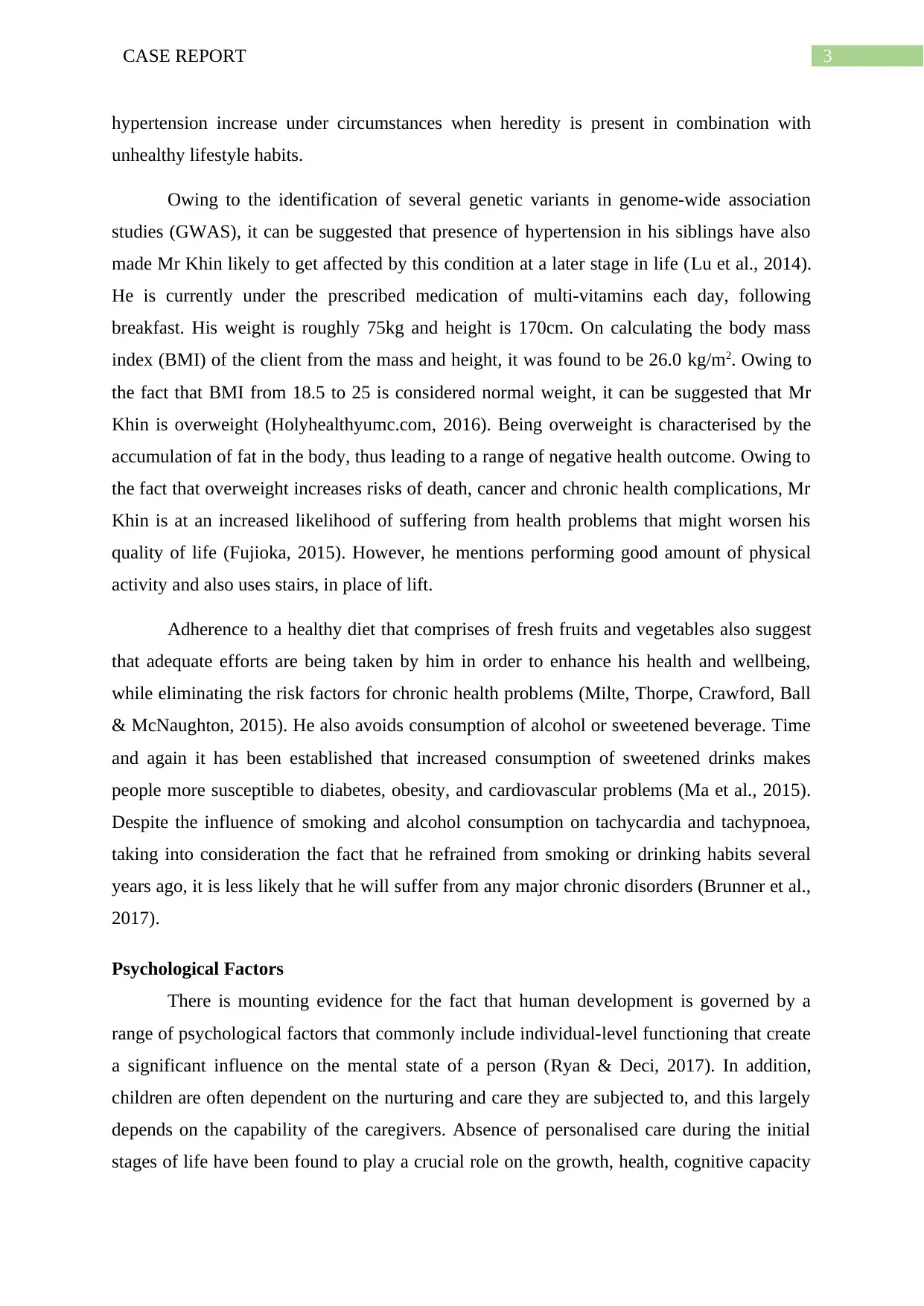
3CASE REPORT
hypertension increase under circumstances when heredity is present in combination with
unhealthy lifestyle habits.
Owing to the identification of several genetic variants in genome-wide association
studies (GWAS), it can be suggested that presence of hypertension in his siblings have also
made Mr Khin likely to get affected by this condition at a later stage in life (Lu et al., 2014).
He is currently under the prescribed medication of multi-vitamins each day, following
breakfast. His weight is roughly 75kg and height is 170cm. On calculating the body mass
index (BMI) of the client from the mass and height, it was found to be 26.0 kg/m2. Owing to
the fact that BMI from 18.5 to 25 is considered normal weight, it can be suggested that Mr
Khin is overweight (Holyhealthyumc.com, 2016). Being overweight is characterised by the
accumulation of fat in the body, thus leading to a range of negative health outcome. Owing to
the fact that overweight increases risks of death, cancer and chronic health complications, Mr
Khin is at an increased likelihood of suffering from health problems that might worsen his
quality of life (Fujioka, 2015). However, he mentions performing good amount of physical
activity and also uses stairs, in place of lift.
Adherence to a healthy diet that comprises of fresh fruits and vegetables also suggest
that adequate efforts are being taken by him in order to enhance his health and wellbeing,
while eliminating the risk factors for chronic health problems (Milte, Thorpe, Crawford, Ball
& McNaughton, 2015). He also avoids consumption of alcohol or sweetened beverage. Time
and again it has been established that increased consumption of sweetened drinks makes
people more susceptible to diabetes, obesity, and cardiovascular problems (Ma et al., 2015).
Despite the influence of smoking and alcohol consumption on tachycardia and tachypnoea,
taking into consideration the fact that he refrained from smoking or drinking habits several
years ago, it is less likely that he will suffer from any major chronic disorders (Brunner et al.,
2017).
Psychological Factors
There is mounting evidence for the fact that human development is governed by a
range of psychological factors that commonly include individual-level functioning that create
a significant influence on the mental state of a person (Ryan & Deci, 2017). In addition,
children are often dependent on the nurturing and care they are subjected to, and this largely
depends on the capability of the caregivers. Absence of personalised care during the initial
stages of life have been found to play a crucial role on the growth, health, cognitive capacity
hypertension increase under circumstances when heredity is present in combination with
unhealthy lifestyle habits.
Owing to the identification of several genetic variants in genome-wide association
studies (GWAS), it can be suggested that presence of hypertension in his siblings have also
made Mr Khin likely to get affected by this condition at a later stage in life (Lu et al., 2014).
He is currently under the prescribed medication of multi-vitamins each day, following
breakfast. His weight is roughly 75kg and height is 170cm. On calculating the body mass
index (BMI) of the client from the mass and height, it was found to be 26.0 kg/m2. Owing to
the fact that BMI from 18.5 to 25 is considered normal weight, it can be suggested that Mr
Khin is overweight (Holyhealthyumc.com, 2016). Being overweight is characterised by the
accumulation of fat in the body, thus leading to a range of negative health outcome. Owing to
the fact that overweight increases risks of death, cancer and chronic health complications, Mr
Khin is at an increased likelihood of suffering from health problems that might worsen his
quality of life (Fujioka, 2015). However, he mentions performing good amount of physical
activity and also uses stairs, in place of lift.
Adherence to a healthy diet that comprises of fresh fruits and vegetables also suggest
that adequate efforts are being taken by him in order to enhance his health and wellbeing,
while eliminating the risk factors for chronic health problems (Milte, Thorpe, Crawford, Ball
& McNaughton, 2015). He also avoids consumption of alcohol or sweetened beverage. Time
and again it has been established that increased consumption of sweetened drinks makes
people more susceptible to diabetes, obesity, and cardiovascular problems (Ma et al., 2015).
Despite the influence of smoking and alcohol consumption on tachycardia and tachypnoea,
taking into consideration the fact that he refrained from smoking or drinking habits several
years ago, it is less likely that he will suffer from any major chronic disorders (Brunner et al.,
2017).
Psychological Factors
There is mounting evidence for the fact that human development is governed by a
range of psychological factors that commonly include individual-level functioning that create
a significant influence on the mental state of a person (Ryan & Deci, 2017). In addition,
children are often dependent on the nurturing and care they are subjected to, and this largely
depends on the capability of the caregivers. Absence of personalised care during the initial
stages of life have been found to play a crucial role on the growth, health, cognitive capacity
Paraphrase This Document
Need a fresh take? Get an instant paraphrase of this document with our AI Paraphraser
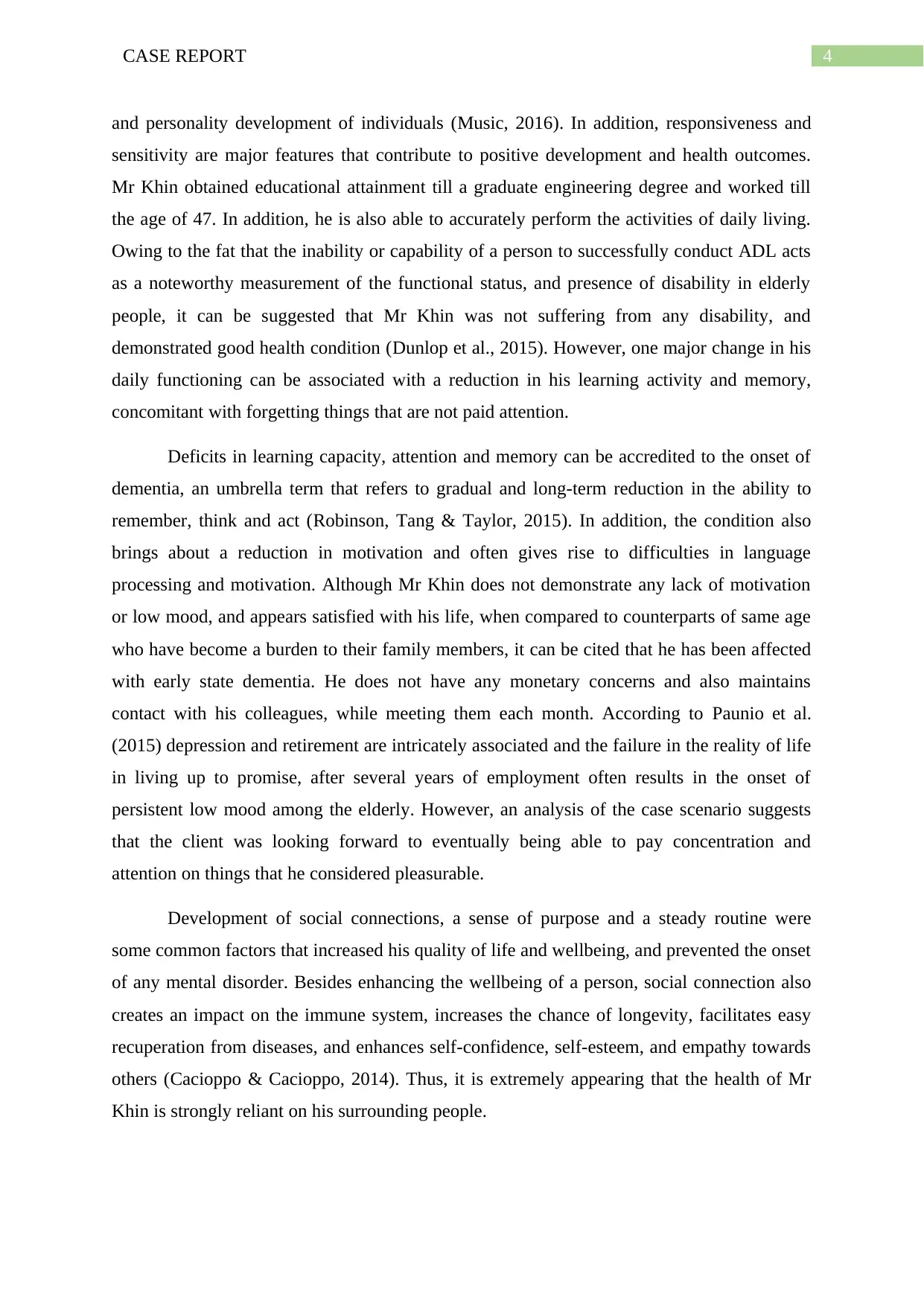
4CASE REPORT
and personality development of individuals (Music, 2016). In addition, responsiveness and
sensitivity are major features that contribute to positive development and health outcomes.
Mr Khin obtained educational attainment till a graduate engineering degree and worked till
the age of 47. In addition, he is also able to accurately perform the activities of daily living.
Owing to the fat that the inability or capability of a person to successfully conduct ADL acts
as a noteworthy measurement of the functional status, and presence of disability in elderly
people, it can be suggested that Mr Khin was not suffering from any disability, and
demonstrated good health condition (Dunlop et al., 2015). However, one major change in his
daily functioning can be associated with a reduction in his learning activity and memory,
concomitant with forgetting things that are not paid attention.
Deficits in learning capacity, attention and memory can be accredited to the onset of
dementia, an umbrella term that refers to gradual and long-term reduction in the ability to
remember, think and act (Robinson, Tang & Taylor, 2015). In addition, the condition also
brings about a reduction in motivation and often gives rise to difficulties in language
processing and motivation. Although Mr Khin does not demonstrate any lack of motivation
or low mood, and appears satisfied with his life, when compared to counterparts of same age
who have become a burden to their family members, it can be cited that he has been affected
with early state dementia. He does not have any monetary concerns and also maintains
contact with his colleagues, while meeting them each month. According to Paunio et al.
(2015) depression and retirement are intricately associated and the failure in the reality of life
in living up to promise, after several years of employment often results in the onset of
persistent low mood among the elderly. However, an analysis of the case scenario suggests
that the client was looking forward to eventually being able to pay concentration and
attention on things that he considered pleasurable.
Development of social connections, a sense of purpose and a steady routine were
some common factors that increased his quality of life and wellbeing, and prevented the onset
of any mental disorder. Besides enhancing the wellbeing of a person, social connection also
creates an impact on the immune system, increases the chance of longevity, facilitates easy
recuperation from diseases, and enhances self-confidence, self-esteem, and empathy towards
others (Cacioppo & Cacioppo, 2014). Thus, it is extremely appearing that the health of Mr
Khin is strongly reliant on his surrounding people.
and personality development of individuals (Music, 2016). In addition, responsiveness and
sensitivity are major features that contribute to positive development and health outcomes.
Mr Khin obtained educational attainment till a graduate engineering degree and worked till
the age of 47. In addition, he is also able to accurately perform the activities of daily living.
Owing to the fat that the inability or capability of a person to successfully conduct ADL acts
as a noteworthy measurement of the functional status, and presence of disability in elderly
people, it can be suggested that Mr Khin was not suffering from any disability, and
demonstrated good health condition (Dunlop et al., 2015). However, one major change in his
daily functioning can be associated with a reduction in his learning activity and memory,
concomitant with forgetting things that are not paid attention.
Deficits in learning capacity, attention and memory can be accredited to the onset of
dementia, an umbrella term that refers to gradual and long-term reduction in the ability to
remember, think and act (Robinson, Tang & Taylor, 2015). In addition, the condition also
brings about a reduction in motivation and often gives rise to difficulties in language
processing and motivation. Although Mr Khin does not demonstrate any lack of motivation
or low mood, and appears satisfied with his life, when compared to counterparts of same age
who have become a burden to their family members, it can be cited that he has been affected
with early state dementia. He does not have any monetary concerns and also maintains
contact with his colleagues, while meeting them each month. According to Paunio et al.
(2015) depression and retirement are intricately associated and the failure in the reality of life
in living up to promise, after several years of employment often results in the onset of
persistent low mood among the elderly. However, an analysis of the case scenario suggests
that the client was looking forward to eventually being able to pay concentration and
attention on things that he considered pleasurable.
Development of social connections, a sense of purpose and a steady routine were
some common factors that increased his quality of life and wellbeing, and prevented the onset
of any mental disorder. Besides enhancing the wellbeing of a person, social connection also
creates an impact on the immune system, increases the chance of longevity, facilitates easy
recuperation from diseases, and enhances self-confidence, self-esteem, and empathy towards
others (Cacioppo & Cacioppo, 2014). Thus, it is extremely appearing that the health of Mr
Khin is strongly reliant on his surrounding people.
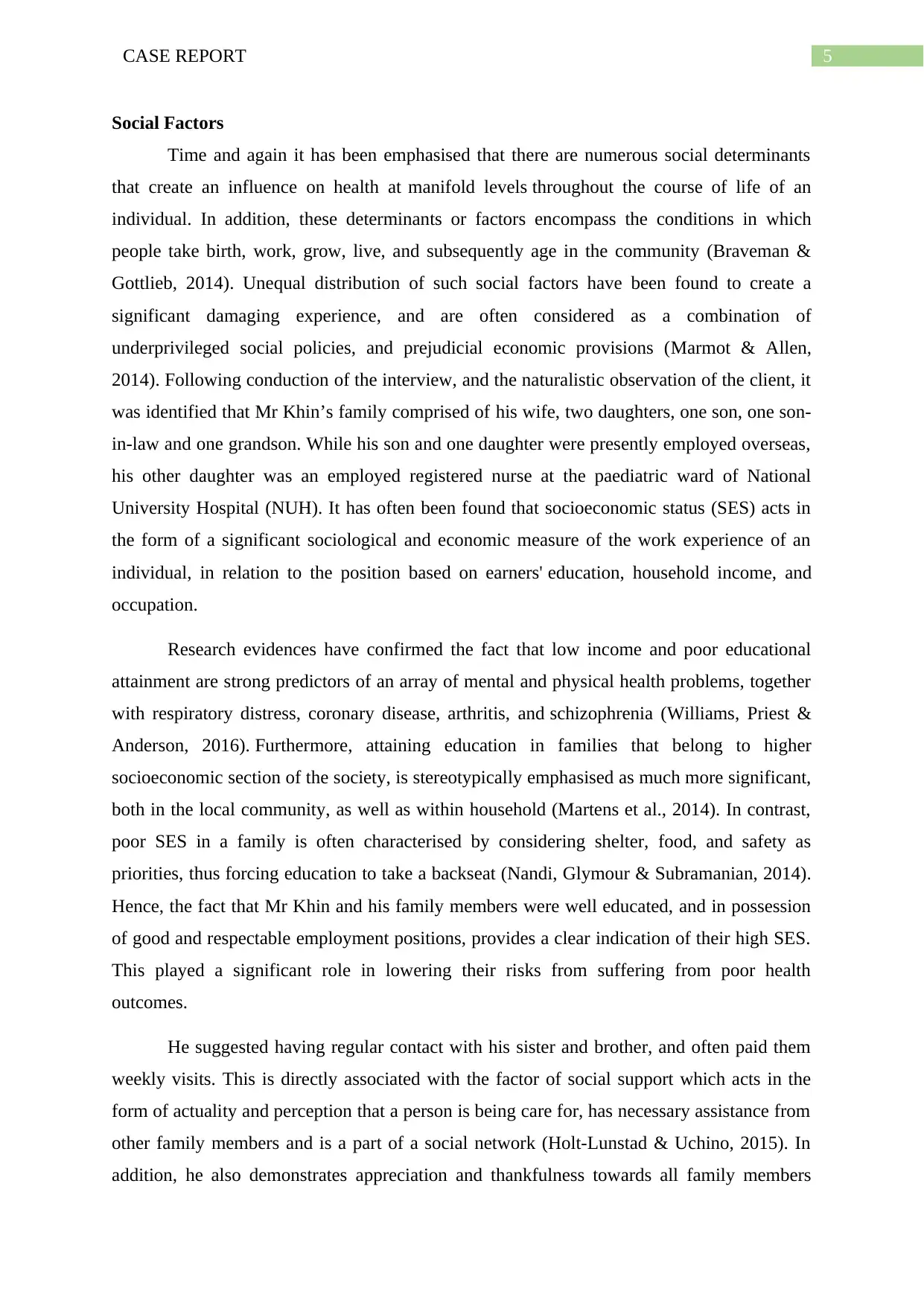
5CASE REPORT
Social Factors
Time and again it has been emphasised that there are numerous social determinants
that create an influence on health at manifold levels throughout the course of life of an
individual. In addition, these determinants or factors encompass the conditions in which
people take birth, work, grow, live, and subsequently age in the community (Braveman &
Gottlieb, 2014). Unequal distribution of such social factors have been found to create a
significant damaging experience, and are often considered as a combination of
underprivileged social policies, and prejudicial economic provisions (Marmot & Allen,
2014). Following conduction of the interview, and the naturalistic observation of the client, it
was identified that Mr Khin’s family comprised of his wife, two daughters, one son, one son-
in-law and one grandson. While his son and one daughter were presently employed overseas,
his other daughter was an employed registered nurse at the paediatric ward of National
University Hospital (NUH). It has often been found that socioeconomic status (SES) acts in
the form of a significant sociological and economic measure of the work experience of an
individual, in relation to the position based on earners' education, household income, and
occupation.
Research evidences have confirmed the fact that low income and poor educational
attainment are strong predictors of an array of mental and physical health problems, together
with respiratory distress, coronary disease, arthritis, and schizophrenia (Williams, Priest &
Anderson, 2016). Furthermore, attaining education in families that belong to higher
socioeconomic section of the society, is stereotypically emphasised as much more significant,
both in the local community, as well as within household (Martens et al., 2014). In contrast,
poor SES in a family is often characterised by considering shelter, food, and safety as
priorities, thus forcing education to take a backseat (Nandi, Glymour & Subramanian, 2014).
Hence, the fact that Mr Khin and his family members were well educated, and in possession
of good and respectable employment positions, provides a clear indication of their high SES.
This played a significant role in lowering their risks from suffering from poor health
outcomes.
He suggested having regular contact with his sister and brother, and often paid them
weekly visits. This is directly associated with the factor of social support which acts in the
form of actuality and perception that a person is being care for, has necessary assistance from
other family members and is a part of a social network (Holt-Lunstad & Uchino, 2015). In
addition, he also demonstrates appreciation and thankfulness towards all family members
Social Factors
Time and again it has been emphasised that there are numerous social determinants
that create an influence on health at manifold levels throughout the course of life of an
individual. In addition, these determinants or factors encompass the conditions in which
people take birth, work, grow, live, and subsequently age in the community (Braveman &
Gottlieb, 2014). Unequal distribution of such social factors have been found to create a
significant damaging experience, and are often considered as a combination of
underprivileged social policies, and prejudicial economic provisions (Marmot & Allen,
2014). Following conduction of the interview, and the naturalistic observation of the client, it
was identified that Mr Khin’s family comprised of his wife, two daughters, one son, one son-
in-law and one grandson. While his son and one daughter were presently employed overseas,
his other daughter was an employed registered nurse at the paediatric ward of National
University Hospital (NUH). It has often been found that socioeconomic status (SES) acts in
the form of a significant sociological and economic measure of the work experience of an
individual, in relation to the position based on earners' education, household income, and
occupation.
Research evidences have confirmed the fact that low income and poor educational
attainment are strong predictors of an array of mental and physical health problems, together
with respiratory distress, coronary disease, arthritis, and schizophrenia (Williams, Priest &
Anderson, 2016). Furthermore, attaining education in families that belong to higher
socioeconomic section of the society, is stereotypically emphasised as much more significant,
both in the local community, as well as within household (Martens et al., 2014). In contrast,
poor SES in a family is often characterised by considering shelter, food, and safety as
priorities, thus forcing education to take a backseat (Nandi, Glymour & Subramanian, 2014).
Hence, the fact that Mr Khin and his family members were well educated, and in possession
of good and respectable employment positions, provides a clear indication of their high SES.
This played a significant role in lowering their risks from suffering from poor health
outcomes.
He suggested having regular contact with his sister and brother, and often paid them
weekly visits. This is directly associated with the factor of social support which acts in the
form of actuality and perception that a person is being care for, has necessary assistance from
other family members and is a part of a social network (Holt-Lunstad & Uchino, 2015). In
addition, he also demonstrates appreciation and thankfulness towards all family members
⊘ This is a preview!⊘
Do you want full access?
Subscribe today to unlock all pages.

Trusted by 1+ million students worldwide
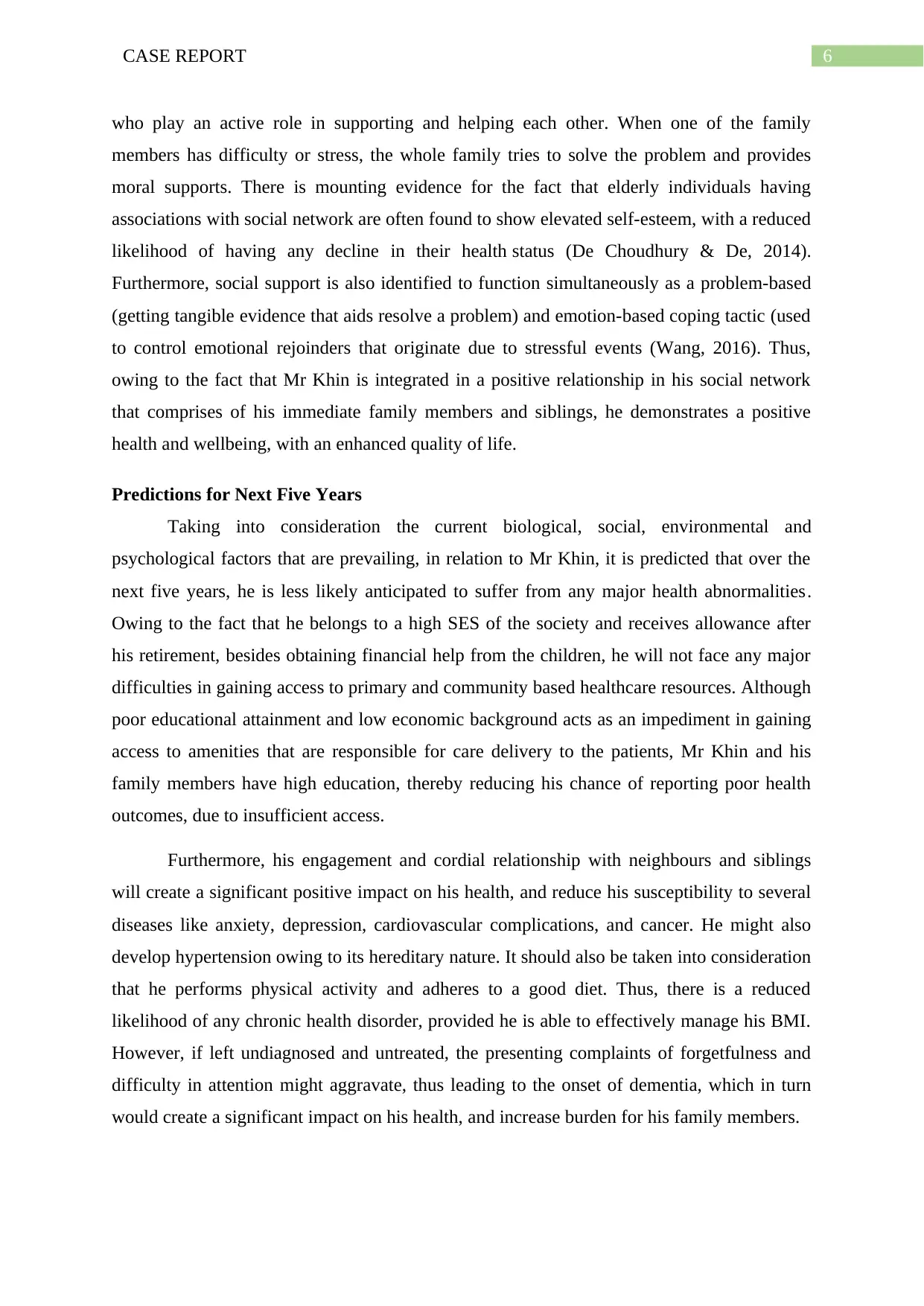
6CASE REPORT
who play an active role in supporting and helping each other. When one of the family
members has difficulty or stress, the whole family tries to solve the problem and provides
moral supports. There is mounting evidence for the fact that elderly individuals having
associations with social network are often found to show elevated self-esteem, with a reduced
likelihood of having any decline in their health status (De Choudhury & De, 2014).
Furthermore, social support is also identified to function simultaneously as a problem-based
(getting tangible evidence that aids resolve a problem) and emotion-based coping tactic (used
to control emotional rejoinders that originate due to stressful events (Wang, 2016). Thus,
owing to the fact that Mr Khin is integrated in a positive relationship in his social network
that comprises of his immediate family members and siblings, he demonstrates a positive
health and wellbeing, with an enhanced quality of life.
Predictions for Next Five Years
Taking into consideration the current biological, social, environmental and
psychological factors that are prevailing, in relation to Mr Khin, it is predicted that over the
next five years, he is less likely anticipated to suffer from any major health abnormalities.
Owing to the fact that he belongs to a high SES of the society and receives allowance after
his retirement, besides obtaining financial help from the children, he will not face any major
difficulties in gaining access to primary and community based healthcare resources. Although
poor educational attainment and low economic background acts as an impediment in gaining
access to amenities that are responsible for care delivery to the patients, Mr Khin and his
family members have high education, thereby reducing his chance of reporting poor health
outcomes, due to insufficient access.
Furthermore, his engagement and cordial relationship with neighbours and siblings
will create a significant positive impact on his health, and reduce his susceptibility to several
diseases like anxiety, depression, cardiovascular complications, and cancer. He might also
develop hypertension owing to its hereditary nature. It should also be taken into consideration
that he performs physical activity and adheres to a good diet. Thus, there is a reduced
likelihood of any chronic health disorder, provided he is able to effectively manage his BMI.
However, if left undiagnosed and untreated, the presenting complaints of forgetfulness and
difficulty in attention might aggravate, thus leading to the onset of dementia, which in turn
would create a significant impact on his health, and increase burden for his family members.
who play an active role in supporting and helping each other. When one of the family
members has difficulty or stress, the whole family tries to solve the problem and provides
moral supports. There is mounting evidence for the fact that elderly individuals having
associations with social network are often found to show elevated self-esteem, with a reduced
likelihood of having any decline in their health status (De Choudhury & De, 2014).
Furthermore, social support is also identified to function simultaneously as a problem-based
(getting tangible evidence that aids resolve a problem) and emotion-based coping tactic (used
to control emotional rejoinders that originate due to stressful events (Wang, 2016). Thus,
owing to the fact that Mr Khin is integrated in a positive relationship in his social network
that comprises of his immediate family members and siblings, he demonstrates a positive
health and wellbeing, with an enhanced quality of life.
Predictions for Next Five Years
Taking into consideration the current biological, social, environmental and
psychological factors that are prevailing, in relation to Mr Khin, it is predicted that over the
next five years, he is less likely anticipated to suffer from any major health abnormalities.
Owing to the fact that he belongs to a high SES of the society and receives allowance after
his retirement, besides obtaining financial help from the children, he will not face any major
difficulties in gaining access to primary and community based healthcare resources. Although
poor educational attainment and low economic background acts as an impediment in gaining
access to amenities that are responsible for care delivery to the patients, Mr Khin and his
family members have high education, thereby reducing his chance of reporting poor health
outcomes, due to insufficient access.
Furthermore, his engagement and cordial relationship with neighbours and siblings
will create a significant positive impact on his health, and reduce his susceptibility to several
diseases like anxiety, depression, cardiovascular complications, and cancer. He might also
develop hypertension owing to its hereditary nature. It should also be taken into consideration
that he performs physical activity and adheres to a good diet. Thus, there is a reduced
likelihood of any chronic health disorder, provided he is able to effectively manage his BMI.
However, if left undiagnosed and untreated, the presenting complaints of forgetfulness and
difficulty in attention might aggravate, thus leading to the onset of dementia, which in turn
would create a significant impact on his health, and increase burden for his family members.
Paraphrase This Document
Need a fresh take? Get an instant paraphrase of this document with our AI Paraphraser

7CASE REPORT
Conclusion
To conclude, the case study involved Mr Khin who did not manifest any major
deterioration in his health and wellbeing. Although conducting a naturalistic observation and
interview facilitated gaining an insight into major aspects of his life that might have shaped
the current scenario, there were few limitations. The interview based data collection process
was time-consuming. In addition, controlling outside variables during naturalistic observation
was difficult, and it generated a vast amount of subjective data.
Conclusion
To conclude, the case study involved Mr Khin who did not manifest any major
deterioration in his health and wellbeing. Although conducting a naturalistic observation and
interview facilitated gaining an insight into major aspects of his life that might have shaped
the current scenario, there were few limitations. The interview based data collection process
was time-consuming. In addition, controlling outside variables during naturalistic observation
was difficult, and it generated a vast amount of subjective data.
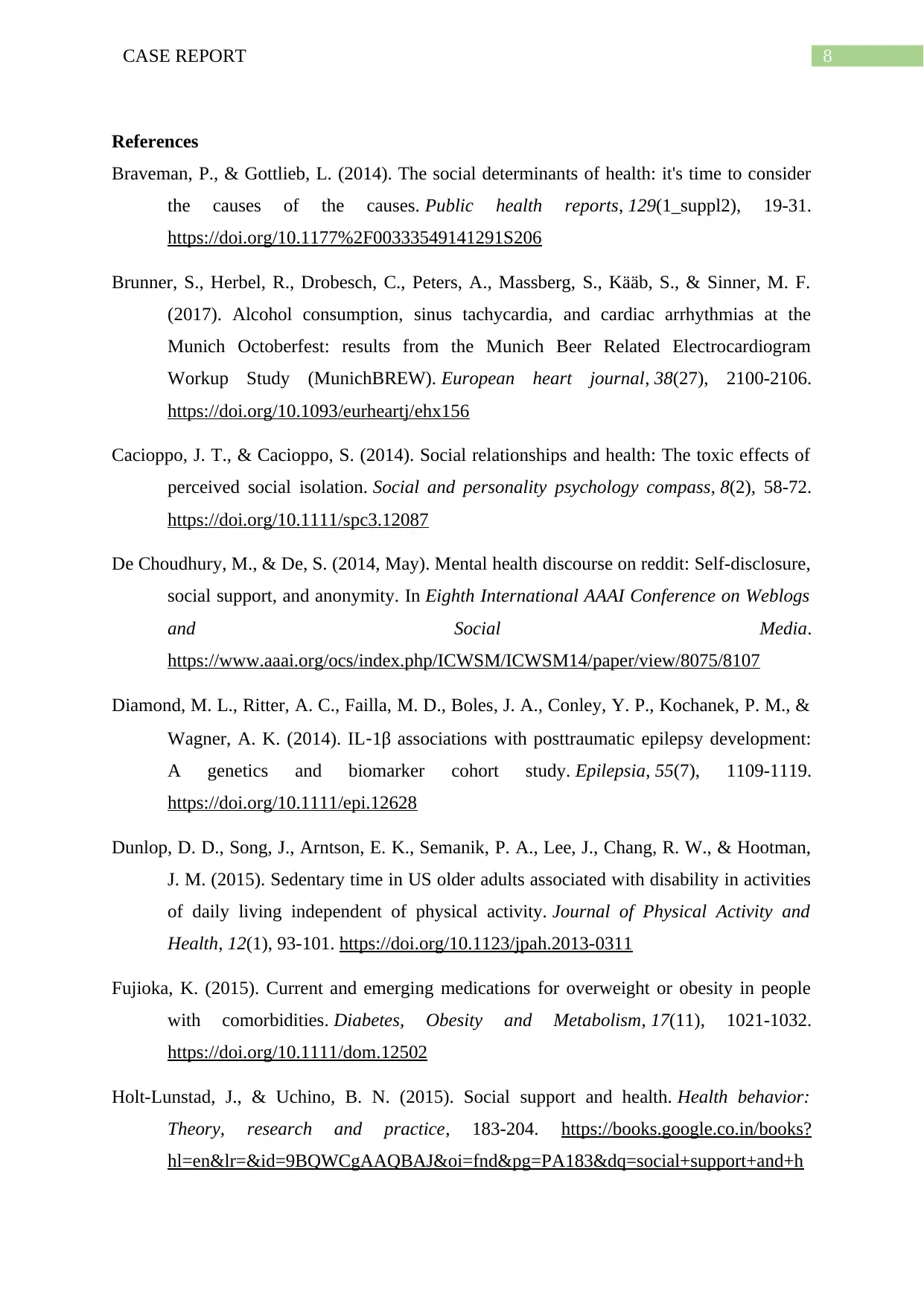
8CASE REPORT
References
Braveman, P., & Gottlieb, L. (2014). The social determinants of health: it's time to consider
the causes of the causes. Public health reports, 129(1_suppl2), 19-31.
https://doi.org/10.1177%2F00333549141291S206
Brunner, S., Herbel, R., Drobesch, C., Peters, A., Massberg, S., Kääb, S., & Sinner, M. F.
(2017). Alcohol consumption, sinus tachycardia, and cardiac arrhythmias at the
Munich Octoberfest: results from the Munich Beer Related Electrocardiogram
Workup Study (MunichBREW). European heart journal, 38(27), 2100-2106.
https://doi.org/10.1093/eurheartj/ehx156
Cacioppo, J. T., & Cacioppo, S. (2014). Social relationships and health: The toxic effects of
perceived social isolation. Social and personality psychology compass, 8(2), 58-72.
https://doi.org/10.1111/spc3.12087
De Choudhury, M., & De, S. (2014, May). Mental health discourse on reddit: Self-disclosure,
social support, and anonymity. In Eighth International AAAI Conference on Weblogs
and Social Media.
https://www.aaai.org/ocs/index.php/ICWSM/ICWSM14/paper/view/8075/8107
Diamond, M. L., Ritter, A. C., Failla, M. D., Boles, J. A., Conley, Y. P., Kochanek, P. M., &
Wagner, A. K. (2014). IL‐1β associations with posttraumatic epilepsy development:
A genetics and biomarker cohort study. Epilepsia, 55(7), 1109-1119.
https://doi.org/10.1111/epi.12628
Dunlop, D. D., Song, J., Arntson, E. K., Semanik, P. A., Lee, J., Chang, R. W., & Hootman,
J. M. (2015). Sedentary time in US older adults associated with disability in activities
of daily living independent of physical activity. Journal of Physical Activity and
Health, 12(1), 93-101. https://doi.org/10.1123/jpah.2013-0311
Fujioka, K. (2015). Current and emerging medications for overweight or obesity in people
with comorbidities. Diabetes, Obesity and Metabolism, 17(11), 1021-1032.
https://doi.org/10.1111/dom.12502
Holt-Lunstad, J., & Uchino, B. N. (2015). Social support and health. Health behavior:
Theory, research and practice, 183-204. https://books.google.co.in/books?
hl=en&lr=&id=9BQWCgAAQBAJ&oi=fnd&pg=PA183&dq=social+support+and+h
References
Braveman, P., & Gottlieb, L. (2014). The social determinants of health: it's time to consider
the causes of the causes. Public health reports, 129(1_suppl2), 19-31.
https://doi.org/10.1177%2F00333549141291S206
Brunner, S., Herbel, R., Drobesch, C., Peters, A., Massberg, S., Kääb, S., & Sinner, M. F.
(2017). Alcohol consumption, sinus tachycardia, and cardiac arrhythmias at the
Munich Octoberfest: results from the Munich Beer Related Electrocardiogram
Workup Study (MunichBREW). European heart journal, 38(27), 2100-2106.
https://doi.org/10.1093/eurheartj/ehx156
Cacioppo, J. T., & Cacioppo, S. (2014). Social relationships and health: The toxic effects of
perceived social isolation. Social and personality psychology compass, 8(2), 58-72.
https://doi.org/10.1111/spc3.12087
De Choudhury, M., & De, S. (2014, May). Mental health discourse on reddit: Self-disclosure,
social support, and anonymity. In Eighth International AAAI Conference on Weblogs
and Social Media.
https://www.aaai.org/ocs/index.php/ICWSM/ICWSM14/paper/view/8075/8107
Diamond, M. L., Ritter, A. C., Failla, M. D., Boles, J. A., Conley, Y. P., Kochanek, P. M., &
Wagner, A. K. (2014). IL‐1β associations with posttraumatic epilepsy development:
A genetics and biomarker cohort study. Epilepsia, 55(7), 1109-1119.
https://doi.org/10.1111/epi.12628
Dunlop, D. D., Song, J., Arntson, E. K., Semanik, P. A., Lee, J., Chang, R. W., & Hootman,
J. M. (2015). Sedentary time in US older adults associated with disability in activities
of daily living independent of physical activity. Journal of Physical Activity and
Health, 12(1), 93-101. https://doi.org/10.1123/jpah.2013-0311
Fujioka, K. (2015). Current and emerging medications for overweight or obesity in people
with comorbidities. Diabetes, Obesity and Metabolism, 17(11), 1021-1032.
https://doi.org/10.1111/dom.12502
Holt-Lunstad, J., & Uchino, B. N. (2015). Social support and health. Health behavior:
Theory, research and practice, 183-204. https://books.google.co.in/books?
hl=en&lr=&id=9BQWCgAAQBAJ&oi=fnd&pg=PA183&dq=social+support+and+h
⊘ This is a preview!⊘
Do you want full access?
Subscribe today to unlock all pages.

Trusted by 1+ million students worldwide
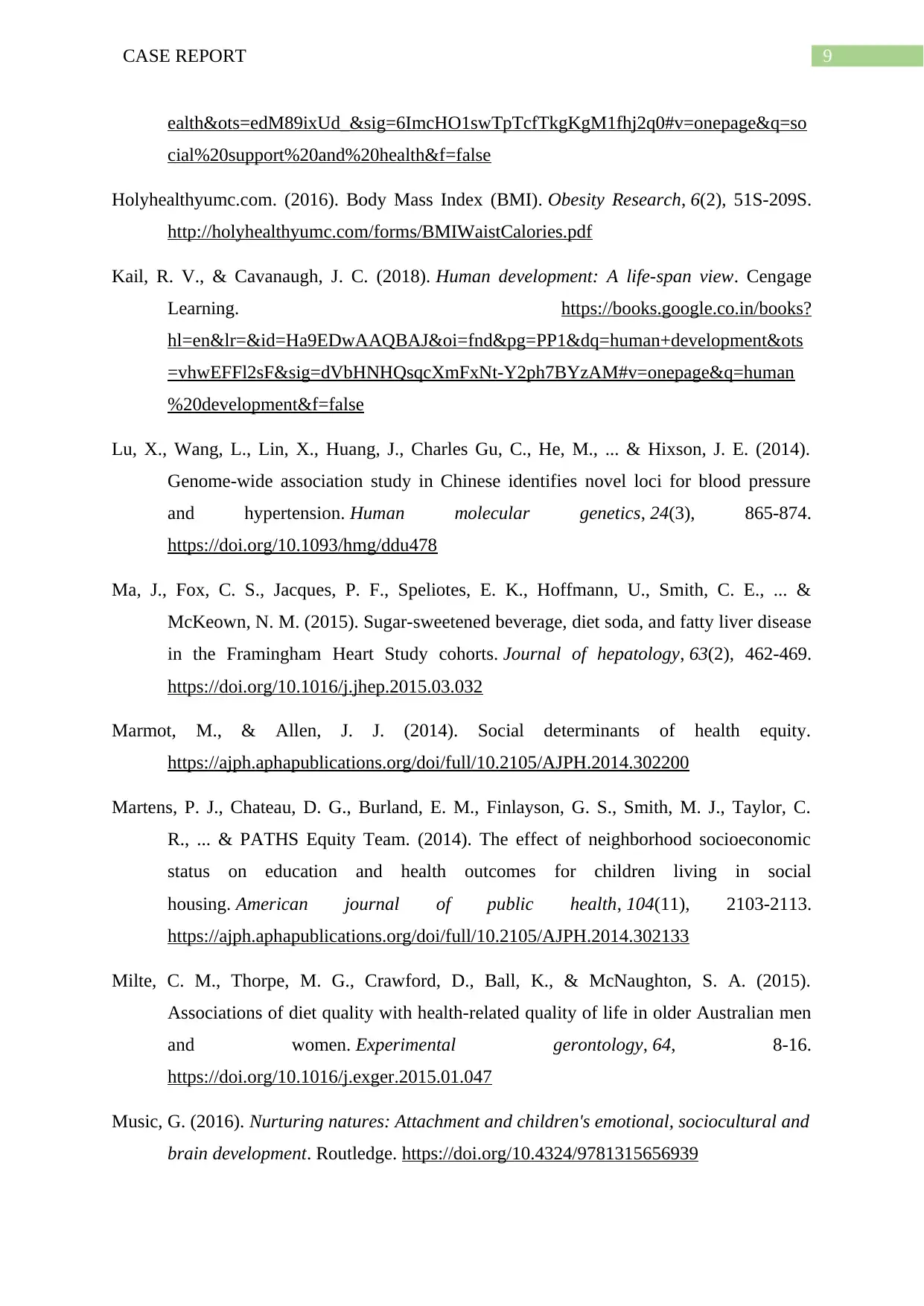
9CASE REPORT
ealth&ots=edM89ixUd_&sig=6ImcHO1swTpTcfTkgKgM1fhj2q0#v=onepage&q=so
cial%20support%20and%20health&f=false
Holyhealthyumc.com. (2016). Body Mass Index (BMI). Obesity Research, 6(2), 51S-209S.
http://holyhealthyumc.com/forms/BMIWaistCalories.pdf
Kail, R. V., & Cavanaugh, J. C. (2018). Human development: A life-span view. Cengage
Learning. https://books.google.co.in/books?
hl=en&lr=&id=Ha9EDwAAQBAJ&oi=fnd&pg=PP1&dq=human+development&ots
=vhwEFFl2sF&sig=dVbHNHQsqcXmFxNt-Y2ph7BYzAM#v=onepage&q=human
%20development&f=false
Lu, X., Wang, L., Lin, X., Huang, J., Charles Gu, C., He, M., ... & Hixson, J. E. (2014).
Genome-wide association study in Chinese identifies novel loci for blood pressure
and hypertension. Human molecular genetics, 24(3), 865-874.
https://doi.org/10.1093/hmg/ddu478
Ma, J., Fox, C. S., Jacques, P. F., Speliotes, E. K., Hoffmann, U., Smith, C. E., ... &
McKeown, N. M. (2015). Sugar-sweetened beverage, diet soda, and fatty liver disease
in the Framingham Heart Study cohorts. Journal of hepatology, 63(2), 462-469.
https://doi.org/10.1016/j.jhep.2015.03.032
Marmot, M., & Allen, J. J. (2014). Social determinants of health equity.
https://ajph.aphapublications.org/doi/full/10.2105/AJPH.2014.302200
Martens, P. J., Chateau, D. G., Burland, E. M., Finlayson, G. S., Smith, M. J., Taylor, C.
R., ... & PATHS Equity Team. (2014). The effect of neighborhood socioeconomic
status on education and health outcomes for children living in social
housing. American journal of public health, 104(11), 2103-2113.
https://ajph.aphapublications.org/doi/full/10.2105/AJPH.2014.302133
Milte, C. M., Thorpe, M. G., Crawford, D., Ball, K., & McNaughton, S. A. (2015).
Associations of diet quality with health-related quality of life in older Australian men
and women. Experimental gerontology, 64, 8-16.
https://doi.org/10.1016/j.exger.2015.01.047
Music, G. (2016). Nurturing natures: Attachment and children's emotional, sociocultural and
brain development. Routledge. https://doi.org/10.4324/9781315656939
ealth&ots=edM89ixUd_&sig=6ImcHO1swTpTcfTkgKgM1fhj2q0#v=onepage&q=so
cial%20support%20and%20health&f=false
Holyhealthyumc.com. (2016). Body Mass Index (BMI). Obesity Research, 6(2), 51S-209S.
http://holyhealthyumc.com/forms/BMIWaistCalories.pdf
Kail, R. V., & Cavanaugh, J. C. (2018). Human development: A life-span view. Cengage
Learning. https://books.google.co.in/books?
hl=en&lr=&id=Ha9EDwAAQBAJ&oi=fnd&pg=PP1&dq=human+development&ots
=vhwEFFl2sF&sig=dVbHNHQsqcXmFxNt-Y2ph7BYzAM#v=onepage&q=human
%20development&f=false
Lu, X., Wang, L., Lin, X., Huang, J., Charles Gu, C., He, M., ... & Hixson, J. E. (2014).
Genome-wide association study in Chinese identifies novel loci for blood pressure
and hypertension. Human molecular genetics, 24(3), 865-874.
https://doi.org/10.1093/hmg/ddu478
Ma, J., Fox, C. S., Jacques, P. F., Speliotes, E. K., Hoffmann, U., Smith, C. E., ... &
McKeown, N. M. (2015). Sugar-sweetened beverage, diet soda, and fatty liver disease
in the Framingham Heart Study cohorts. Journal of hepatology, 63(2), 462-469.
https://doi.org/10.1016/j.jhep.2015.03.032
Marmot, M., & Allen, J. J. (2014). Social determinants of health equity.
https://ajph.aphapublications.org/doi/full/10.2105/AJPH.2014.302200
Martens, P. J., Chateau, D. G., Burland, E. M., Finlayson, G. S., Smith, M. J., Taylor, C.
R., ... & PATHS Equity Team. (2014). The effect of neighborhood socioeconomic
status on education and health outcomes for children living in social
housing. American journal of public health, 104(11), 2103-2113.
https://ajph.aphapublications.org/doi/full/10.2105/AJPH.2014.302133
Milte, C. M., Thorpe, M. G., Crawford, D., Ball, K., & McNaughton, S. A. (2015).
Associations of diet quality with health-related quality of life in older Australian men
and women. Experimental gerontology, 64, 8-16.
https://doi.org/10.1016/j.exger.2015.01.047
Music, G. (2016). Nurturing natures: Attachment and children's emotional, sociocultural and
brain development. Routledge. https://doi.org/10.4324/9781315656939
Paraphrase This Document
Need a fresh take? Get an instant paraphrase of this document with our AI Paraphraser
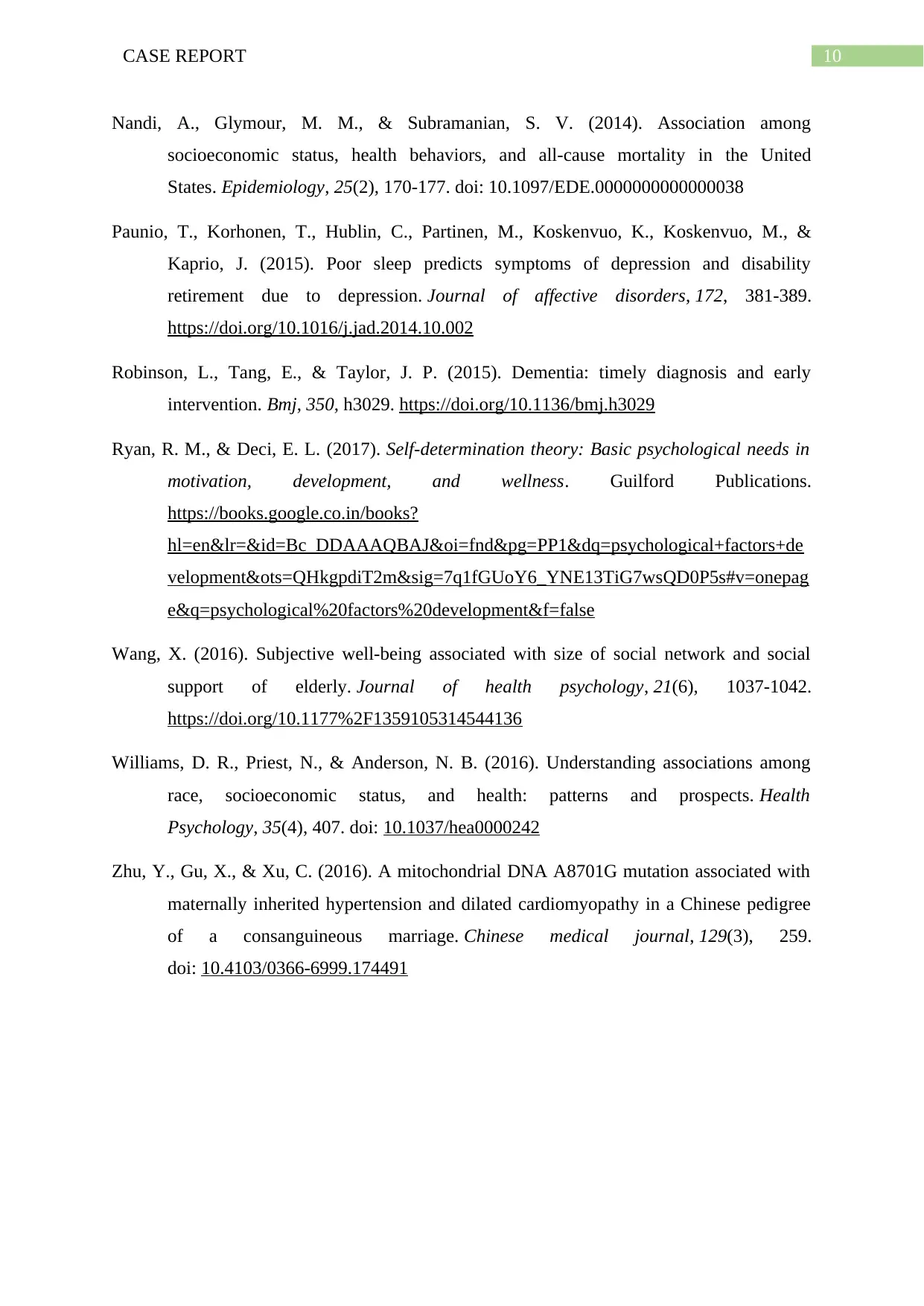
10CASE REPORT
Nandi, A., Glymour, M. M., & Subramanian, S. V. (2014). Association among
socioeconomic status, health behaviors, and all-cause mortality in the United
States. Epidemiology, 25(2), 170-177. doi: 10.1097/EDE.0000000000000038
Paunio, T., Korhonen, T., Hublin, C., Partinen, M., Koskenvuo, K., Koskenvuo, M., &
Kaprio, J. (2015). Poor sleep predicts symptoms of depression and disability
retirement due to depression. Journal of affective disorders, 172, 381-389.
https://doi.org/10.1016/j.jad.2014.10.002
Robinson, L., Tang, E., & Taylor, J. P. (2015). Dementia: timely diagnosis and early
intervention. Bmj, 350, h3029. https://doi.org/10.1136/bmj.h3029
Ryan, R. M., & Deci, E. L. (2017). Self-determination theory: Basic psychological needs in
motivation, development, and wellness. Guilford Publications.
https://books.google.co.in/books?
hl=en&lr=&id=Bc_DDAAAQBAJ&oi=fnd&pg=PP1&dq=psychological+factors+de
velopment&ots=QHkgpdiT2m&sig=7q1fGUoY6_YNE13TiG7wsQD0P5s#v=onepag
e&q=psychological%20factors%20development&f=false
Wang, X. (2016). Subjective well-being associated with size of social network and social
support of elderly. Journal of health psychology, 21(6), 1037-1042.
https://doi.org/10.1177%2F1359105314544136
Williams, D. R., Priest, N., & Anderson, N. B. (2016). Understanding associations among
race, socioeconomic status, and health: patterns and prospects. Health
Psychology, 35(4), 407. doi: 10.1037/hea0000242
Zhu, Y., Gu, X., & Xu, C. (2016). A mitochondrial DNA A8701G mutation associated with
maternally inherited hypertension and dilated cardiomyopathy in a Chinese pedigree
of a consanguineous marriage. Chinese medical journal, 129(3), 259.
doi: 10.4103/0366-6999.174491
Nandi, A., Glymour, M. M., & Subramanian, S. V. (2014). Association among
socioeconomic status, health behaviors, and all-cause mortality in the United
States. Epidemiology, 25(2), 170-177. doi: 10.1097/EDE.0000000000000038
Paunio, T., Korhonen, T., Hublin, C., Partinen, M., Koskenvuo, K., Koskenvuo, M., &
Kaprio, J. (2015). Poor sleep predicts symptoms of depression and disability
retirement due to depression. Journal of affective disorders, 172, 381-389.
https://doi.org/10.1016/j.jad.2014.10.002
Robinson, L., Tang, E., & Taylor, J. P. (2015). Dementia: timely diagnosis and early
intervention. Bmj, 350, h3029. https://doi.org/10.1136/bmj.h3029
Ryan, R. M., & Deci, E. L. (2017). Self-determination theory: Basic psychological needs in
motivation, development, and wellness. Guilford Publications.
https://books.google.co.in/books?
hl=en&lr=&id=Bc_DDAAAQBAJ&oi=fnd&pg=PP1&dq=psychological+factors+de
velopment&ots=QHkgpdiT2m&sig=7q1fGUoY6_YNE13TiG7wsQD0P5s#v=onepag
e&q=psychological%20factors%20development&f=false
Wang, X. (2016). Subjective well-being associated with size of social network and social
support of elderly. Journal of health psychology, 21(6), 1037-1042.
https://doi.org/10.1177%2F1359105314544136
Williams, D. R., Priest, N., & Anderson, N. B. (2016). Understanding associations among
race, socioeconomic status, and health: patterns and prospects. Health
Psychology, 35(4), 407. doi: 10.1037/hea0000242
Zhu, Y., Gu, X., & Xu, C. (2016). A mitochondrial DNA A8701G mutation associated with
maternally inherited hypertension and dilated cardiomyopathy in a Chinese pedigree
of a consanguineous marriage. Chinese medical journal, 129(3), 259.
doi: 10.4103/0366-6999.174491
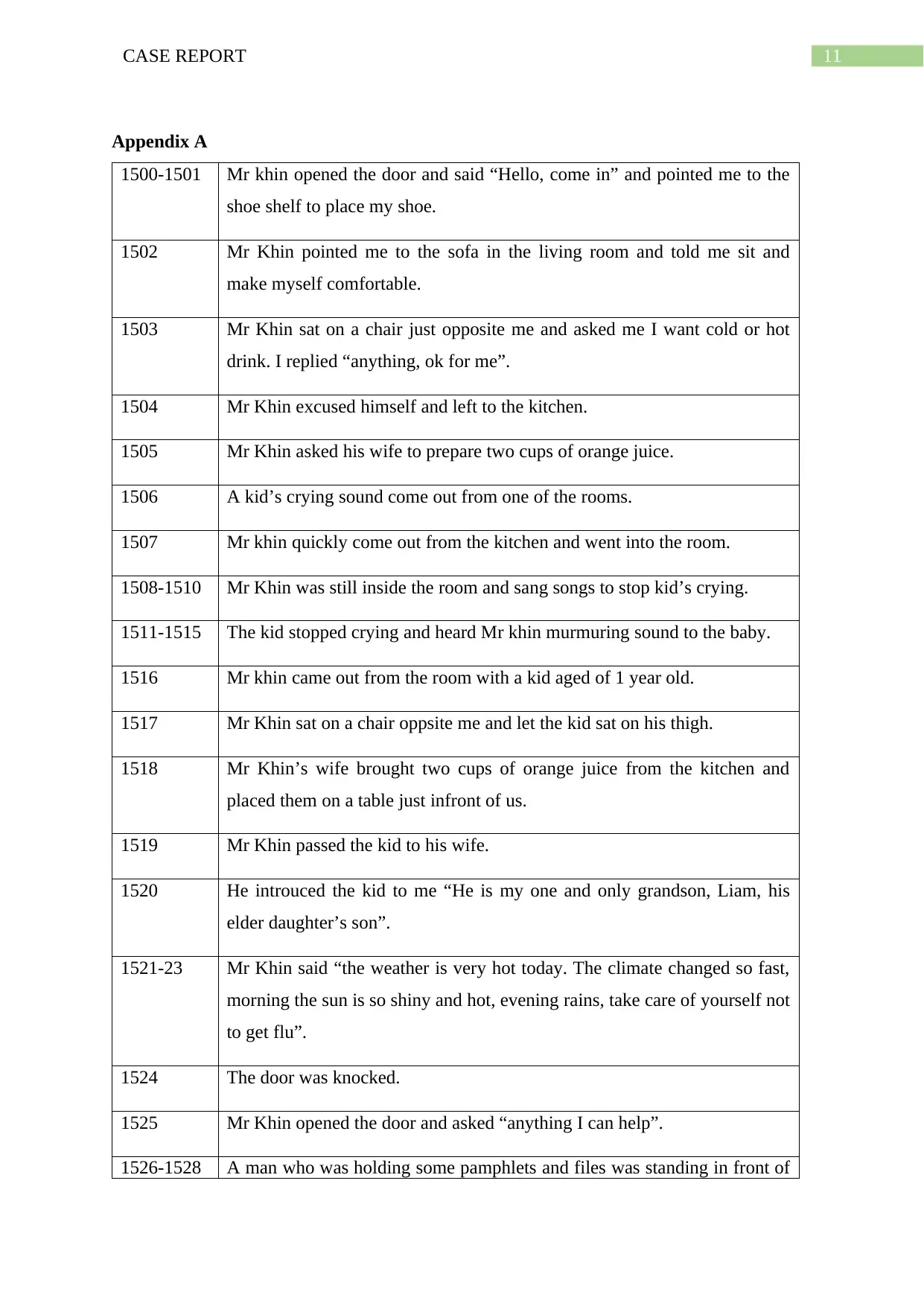
11CASE REPORT
Appendix A
1500-1501 Mr khin opened the door and said “Hello, come in” and pointed me to the
shoe shelf to place my shoe.
1502 Mr Khin pointed me to the sofa in the living room and told me sit and
make myself comfortable.
1503 Mr Khin sat on a chair just opposite me and asked me I want cold or hot
drink. I replied “anything, ok for me”.
1504 Mr Khin excused himself and left to the kitchen.
1505 Mr Khin asked his wife to prepare two cups of orange juice.
1506 A kid’s crying sound come out from one of the rooms.
1507 Mr khin quickly come out from the kitchen and went into the room.
1508-1510 Mr Khin was still inside the room and sang songs to stop kid’s crying.
1511-1515 The kid stopped crying and heard Mr khin murmuring sound to the baby.
1516 Mr khin came out from the room with a kid aged of 1 year old.
1517 Mr Khin sat on a chair oppsite me and let the kid sat on his thigh.
1518 Mr Khin’s wife brought two cups of orange juice from the kitchen and
placed them on a table just infront of us.
1519 Mr Khin passed the kid to his wife.
1520 He introuced the kid to me “He is my one and only grandson, Liam, his
elder daughter’s son”.
1521-23 Mr Khin said “the weather is very hot today. The climate changed so fast,
morning the sun is so shiny and hot, evening rains, take care of yourself not
to get flu”.
1524 The door was knocked.
1525 Mr Khin opened the door and asked “anything I can help”.
1526-1528 A man who was holding some pamphlets and files was standing in front of
Appendix A
1500-1501 Mr khin opened the door and said “Hello, come in” and pointed me to the
shoe shelf to place my shoe.
1502 Mr Khin pointed me to the sofa in the living room and told me sit and
make myself comfortable.
1503 Mr Khin sat on a chair just opposite me and asked me I want cold or hot
drink. I replied “anything, ok for me”.
1504 Mr Khin excused himself and left to the kitchen.
1505 Mr Khin asked his wife to prepare two cups of orange juice.
1506 A kid’s crying sound come out from one of the rooms.
1507 Mr khin quickly come out from the kitchen and went into the room.
1508-1510 Mr Khin was still inside the room and sang songs to stop kid’s crying.
1511-1515 The kid stopped crying and heard Mr khin murmuring sound to the baby.
1516 Mr khin came out from the room with a kid aged of 1 year old.
1517 Mr Khin sat on a chair oppsite me and let the kid sat on his thigh.
1518 Mr Khin’s wife brought two cups of orange juice from the kitchen and
placed them on a table just infront of us.
1519 Mr Khin passed the kid to his wife.
1520 He introuced the kid to me “He is my one and only grandson, Liam, his
elder daughter’s son”.
1521-23 Mr Khin said “the weather is very hot today. The climate changed so fast,
morning the sun is so shiny and hot, evening rains, take care of yourself not
to get flu”.
1524 The door was knocked.
1525 Mr Khin opened the door and asked “anything I can help”.
1526-1528 A man who was holding some pamphlets and files was standing in front of
⊘ This is a preview!⊘
Do you want full access?
Subscribe today to unlock all pages.

Trusted by 1+ million students worldwide
1 out of 17
Related Documents
Your All-in-One AI-Powered Toolkit for Academic Success.
+13062052269
info@desklib.com
Available 24*7 on WhatsApp / Email
![[object Object]](/_next/static/media/star-bottom.7253800d.svg)
Unlock your academic potential
Copyright © 2020–2025 A2Z Services. All Rights Reserved. Developed and managed by ZUCOL.




